 |
||
|
||
| ||
The complex situation in the sector of budget coolers for Intel LGA775 platform can be described with a single concise and simple word. This word is deficit. Even if the deficit here has to do with the range of products rather than with their quantities — the choice of styles and models of budget coolers is very small, of course, but it's sufficient at the very least — the key of the problem remains. That's the way of the world from time immemorial: Intel has always tried to provide good cooling systems for their boxed processors. Thus it actually discouraged the largest cooler makers to manufacture budget models. Today Intel keeps to the beaten track. The results are obvious — the list of manufacturers, who want to try hand at the low-profit and high-competition sector of budget cooling systems, is waning. That's the reason for another indicative activity — the fashion for cloning the boxed cooler design. The essence is simple — vendors prefer to save on R&D: at the best - they adapt the reference design to their technical realia, at the worst — they just buy reference heatsinks and attach fans with their labels (manufactured by well-known mega-mills in continental China). But even though the market does not indulge users with rich assortment of budget coolers for LGA775, it still offers enough model to choose from. To clear up the issue, today we'll focus on 11 coolers, more or less alternative to the boxed modifications — five models of the CI5-9HDPA and CI5-9JD3A series from Cooler Master, four Igloo 5071 models from GlacialTech, as well as two LeopardStream models from Speeze. Well, let's proceed! Cooler Master CI5-9HDPA-0L and CI5-9HDPA-01The first models to be examined today are two budget coolers from Cooler Master — CI5-9HDPA-0L and CI5-9HDPA-01. These coolers are typical for their sector in many aspects — they are based on the aluminum 90x37 mm heatsink with radial finning, equipped with a 92x25 mm fan and the retention system of the reference design. 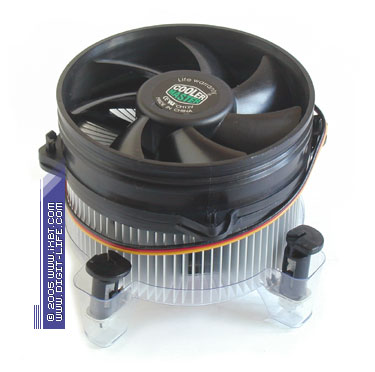 Cooler Master CI5-9HDPA-0L Perhaps, the main point of interest of the CI5-9HDPA series is its combined copper-aluminum heatsink, which is fortified with a 30x29 mm copper core (base diameter is 38 mm), pressed into the finning base. Technical parameters of the finning are also quite decent: the heatsink comprises eighty four 0.6mm fins at 0.8mm steps at the base, the total heat exchange surface is about 1850 cm2. 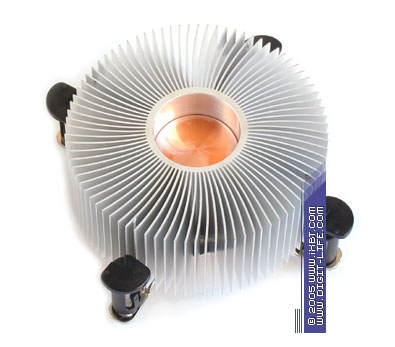 The CI5-9HDPA-0L and CI5-9HDPA-01 models are practically identical to the boxed cooler as far as their operation is concerned: the heatsink is installed with special plastic clips to be pushed though the mounting holes on a motherboard, with all pros and cons of this installation (installation and deinstallation convenience is an advantage, but the cooler is not very tight in the socket). Preinstalled thermal interface is an additional advantage, quite of decent quality at that (thermal-transfer filling agent is a composition of silicon oxide and boron nitride). 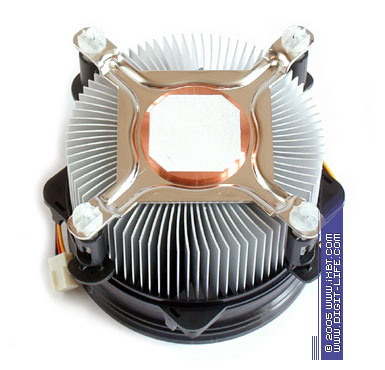 These coolers also look good in terms of thermal efficiency, they compete well with the copper-aluminum boxed modification: the CI5-9HDPA-01 model (nominal rotational speed - 3000 rpm) is practically on a par with the boxed cooler, but demonstrates a significantly lower noise level. The other model — CI5-9HDPA-0L (nominal rotational speed - 2200 rpm) is not a jot worse than a placated boxed model, it's even more ergonomic in terms of noise, shooting ahead in the efficiency-noise ratio. Cooler Master CI5-9JD3A-0L, CI5-9JD3A-01, and CI5-9JD3A-PLThree representatives of the new budget series from Cooler Master — CI5-9JD3A-0L, CI5-9JD3A-01, and CI5-9JD3A-PL are based on practically the same concept design as their predecessors from the CI5-9HDPA series. The updated models have ideologically the same heatsink with a copper core. They are equipped with similar 92x25 mm fans with the rotational speed of 2200, 3000, and 4200 rpm. But at the same time they introduce a number of additions and improvements (e.g. the PL model allows to vary the rotational speed from 2000 to 4200 rpm). 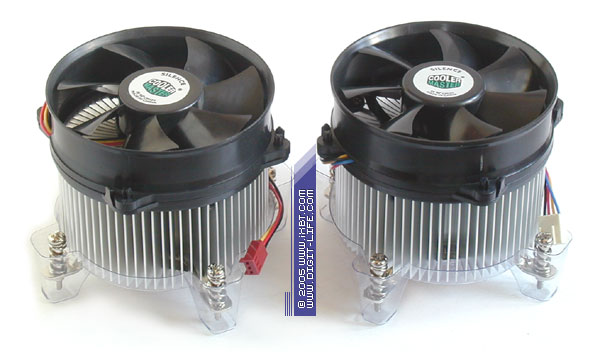 Cooler Master CI5-9JD3A-0L and CI5-9JD3A-PL The retention mechanism of the CI5-9JD3A series has been reconstructed — screw mounting is used instead of the reference system: the coolers come shipped with an additional supporting plate, which is mounted at the back of the motherboard and holds the heatsink in a socket with four screws. Compared to the reference design, this installation method is certainly less convenient — you will have to take a lot of trouble over its installation. But in technical terms, this retention mechanism helps the CI5-9JD3A sit really tight in a socket with reinforced and optimized hold-down pressure, thus ensuring better quality of the thermal contact between the heatsink and a processor. 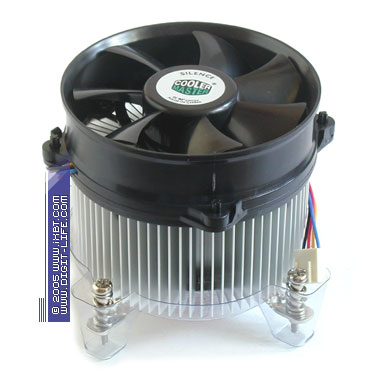 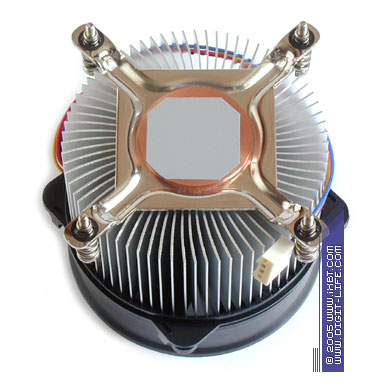 The CI5-9JD3A-series heatsink underwent a modification as well, it became larger (90x45 mm versus 90x37 mm in the CI5-9HDPA) and heavier (530 g versus 460 g in the CI5-9HDPA series). Although the new finning is simplified rather than improved (72 fins, their average thickness is 0.8 mm), the finning step was increased (which naturally reduces flow resistance and facilitates blowing through this heatsink), the total area of the heat exchange surface also grew larger (about 2000 cm2). All these modifications should have a positive effect on thermal characteristics of the CI5-9JD3A. 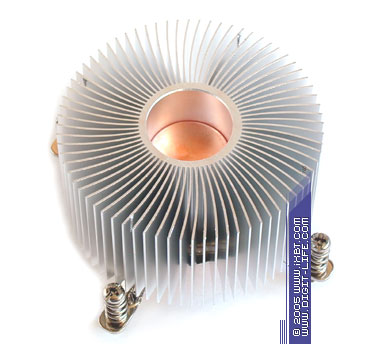 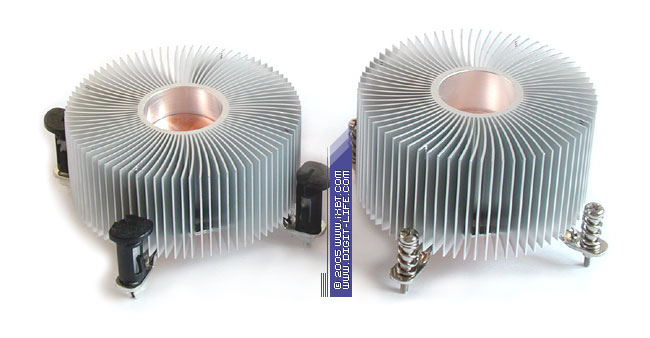 CI5-9HDPA and CI5-9JD3A heatsinks Practice confirmed our optimistic assumptions — CI5-9JD3A series coolers demonstrate quite a ponderable advantage over their CI5-9HDPA predecessors in functional terms. The best results are shown by the CI5-9JD3A-01 model — this cooler outperforms the boxed modification in thermal efficiency, demonstrating much more ergonomic noise characteristics. The CI5-9JD3A-0L looks very good, demonstrating a really low and ergonomic noise level together with decent thermal characteristics. The CI5-9JD3A-PL model also shows decent results, but it sways to and fro — the cooler is not much more thermally efficient than the CI5-9JD3A-01, but it demonstrates excessive energy in terms of noise characteristics, almost reaching the critical 50 dBA. The rotational speed of 4200 rpm is excessive here, it causes an undesirable air flow recirculation and hampers the reduction of thermal resistance of the cooler. GlacialTech Igloo 5071 Silent, Igloo 5071 Light, Igloo 5071, and Igloo 5071 PWMThe next coolers to be examined in our list are from a new budget series from GlacialTech — Igloo 5071, including Igloo 5071 Silent, Igloo 5071 Light, Igloo 5071, and Igloo 5071 PWM. These coolers are based on the aluminum 90x90x48 mm heatsink. They are equipped with 90x90x25 mm fans, traditionally ranking in the rotational speed (1700, 2400, 2800, and 3800 rpm correspondingly). The PWM model is additionally equipped with a rotational speed control circuit (the speed is varied from 1000 to 3800 rpm by system monitoring of the motherboard). 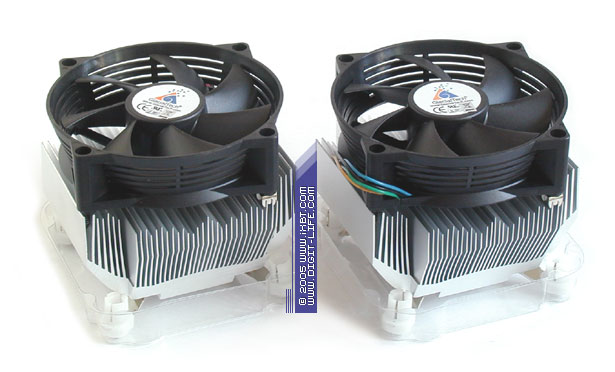 GlacialTech Igloo 5071 and Igloo 5071 PWM Igloo 5071 is essentially a product of development (overhauling is a better word here) of technical ideas, implemented in the previous models from the Igloo 5070 series, both in cosmetic (the new coolers look more attractive) as well as in purely technical terms. 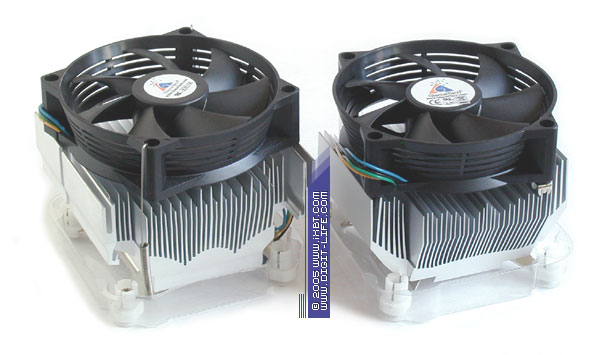 GlacialTech Igloo 5070 PWM and Igloo 5071 PWM Igloo 5071 is the most redesigned model here — not only in form, but also in content. The main acquisition here is a much more developed configuration with denser finning, larded with traditional catalysts of heat efficiency - tapered section fins (0.5 mm thick at the base and 0.2 mm thick at the tip, the average fin step is 1.5 mm) and fin height alternation, which enhance thermal efficiency of the finning and improve the air flow through the heatsink. The heatsink base was also improved — it got a special 60x32x5 mm cut-out, which allowed to optimize channeling the heat from a processor without wave-like bulges and make the heatsink more compact. Thus, due to the improved finning parameters, Igloo 5071 heatsink grew the total area of the heat exchange surface to 2100 cm2 (versus 1600 cm2 in Igloo 5070). But the cooler did not become heavier, it even got lighter by nearly 100 g (440 g versus 530 g in Igloo 5070). 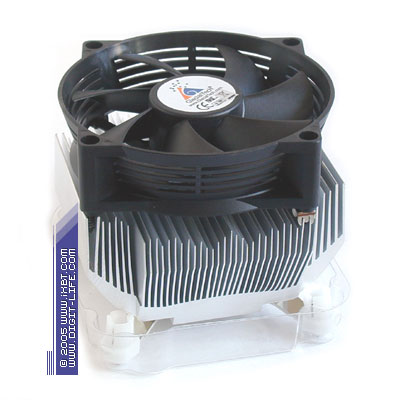 Other technical characteristics of Igloo 5071 (which proved themselves worthy even in the Igloo 5070 series) remained practically unchanged: the retention bracket with screws was insignificantly overhauled, in order to adapt to the new construction of the heatsink base; the fans retained their authenticity — dimensions and the grid pipe, converging in the airflow direction; the preinstalled thermal interface of a good quality is also there (filling agent — a composition of aluminum nitride and oxide). 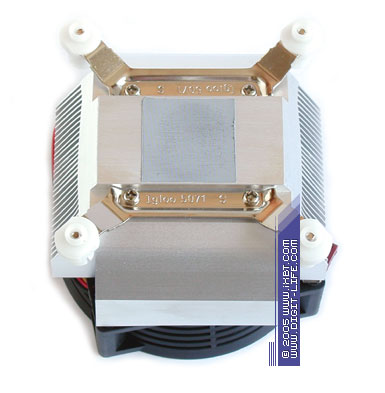 Speaking in terms of pure practice, the complex of changes fits Igloo 5071 very well and charges it up — all models of the new series demonstrate optimized thermal characteristics versus Igloo 5070. In terms of thermal efficiency, Igloo 5071 PWM (3800 rpm) expectedly takes up the lead — this cooler outperforms the robust competitor from Cooler Master — CI5-9JD3A-PL, leaves far behind the boxed model, and comes close to results of higher-classed products. But this victory comes at a great cost, it does not look that peachy in noise terms — a tad lower than the critical mark of 50 dBA. Igloo 5071 and Igloo 5071 Light are more unassuming, but look much more attractive in total functionality than their senior brother — they compete well with the boxed cooler and its clones, demonstrating an ergonomically bearable noise level. Igloo 5071 Silent is the most interesting in this series: it shows decent thermal results and breaks a peculiar budget record — the best efficiency-noise ratio among the budget models we reviewed! To all appearances, Igloo 5071 is adapted to low-power air flow and correspondingly low-noise fans. This solution is quite expedient, as the main task now is to maximize thermal efficiency and simultaneously minimize the noise. As you can see, Igloo 5071 copes with this task well. Speeze LeopardStream 3 and LeopardStream 4And in conclusion of our shootout, two budget coolers from Speeze — LeopardStream 3 and LeopardStream 4. The only common thing between them is that they are low-end models. In technical and constructive terms these models are very different. LeopardStream 3 is nearly a complete copy of the boxed cooler — this model is based on a reference heatsink with radial finning (90x38 mm). It's equipped with the reference retention mechanism, but spiced up with a more attractive 92x25 mm fan with the nominal rotational speed of 2400 rpm. 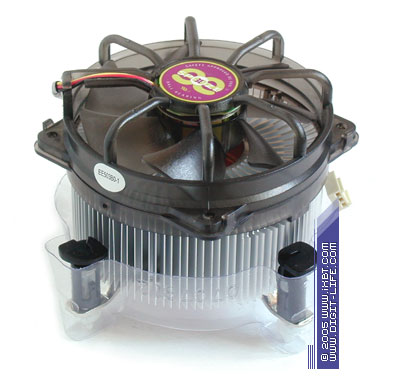 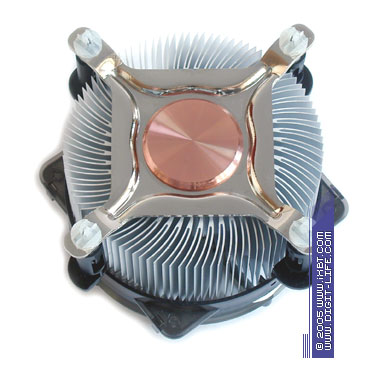 Strict compliance with the reference design naturally causes mixed feelings about LeopardStream 3. On the one hand, the boxed radial finning design with its typical bifurcated fins theoretically looks interesting and allows to improve thermal parameters of the heatsink. But on the other hand, this design is not quite inspiring in practice, to tell the truth. 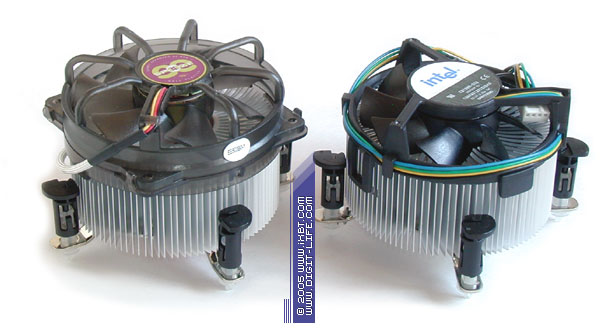 Speeze LeopardStream 3 and a boxed cooler No matter what, 52 bifurcated fins provide just about 1600 cm2 of the heat exchange surface area. But in case of the CI5-9HDPA from Cooler Master, which has similar finning dimensions, but is notable for a much simpler fin shape, the heat exchange surface is increased to 1850 cm2. Evidently, such a state of affairs does not promote the reduction of thermal resistance of a cooler. A coreless copper heatsink has a negative impact on thermal parameters of the LeopardStream 3 — it certainly saves weight, but a solid cylindrical core would have been better in thermal terms, from the point of view of optimal heat redistribution.  As a result, all this reduces the technical potential of LeopardStream 3 — the cooler will have the same fate as its similarly-equipped boxed predecessor: it cannot boast of excellent results, even if it keeps to the ergonimic noise level. Another budget cooler in the Speeze series, LeopardStream 4, is based on an aluminum 90x90x50 mm heatsink with traditional plate finning. It's equipped with a fan, similar to that in LeopardStream 3, but less noisy, (nominal rotational speed is 1800 rpm) and a retention mechanism with screws. 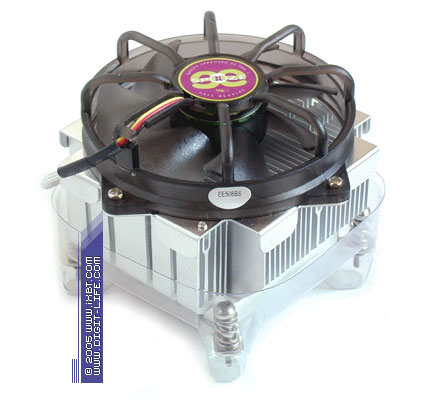 LeopardStream 4 is no genius in technical terms — heatsink of a simplified finning configuration with somewhat archaic parameters (standard rectangular fins, 0.9 mm thick, at 2 mm steps). Although the total area of heat exchange surface is 1700 cm2, weak finning optimization leaves little chance to demonstrate improved thermal characteristics. So it is in practice: though better than the purely aluminum boxed model, LeopardStream 4 cannot catch up with the other competitors — representatives from Cooler Master and GlacialTech (but we should do justice to this cooler, we have no gripes with its noise ergonomics — the noise level is really low). 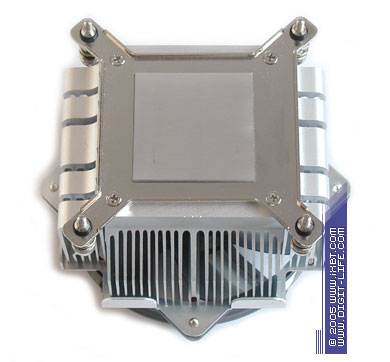 LeopardStream 4 could have really attracted attention with its retention mechanism providing tight installation of the cooler on the socket. But unfortunately, there is a problem even here: for unknown reasons, the bundled support plate is made of plastic with pressed mounting rings. Thanks to this would-be cunning construction, this plate survives one (maximum two) installations and then breaks (the plastic just fails). As a result, LeopardStream 4 is actually a "disposable" cooler — sad, but true. 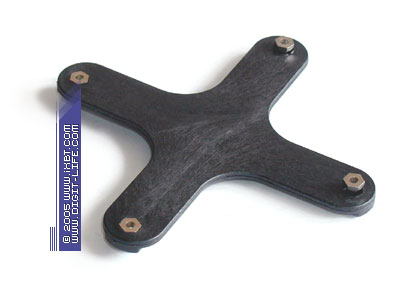 The supporting plate of LeopardStream 4, mounting rings (on the right) are out of their seats due to the broken plastic On this optimistic note our today's shootout of budget coolers from Cooler Master, GlacialTech and Speeze comes to an end. It's time to draw a bottom line! But first let's have a look at the test results. Test resultsIn order to examine thermal efficiency of our LGA775 coolers, we put the same methods into service as in testing cooling systems for Socket A, Socket 478, and Socket 754/939. The primary data used for the consequent calculation of thermal resistance are temperature readings of the thermal diode built into a processor, only the thermal source is different (now it's Pentium 4 550 processor), the base platform (ASUS P5AD2-E Premium motherboard), and a set of test applications. The testbed has the following configuration:
We use the S&M utility to simulate maximum thermal load of a processor, and Speedfan - to monitor temperatures. Thermal Monitor is disabled in all the tests. Diagram 1. Temperature readings Notes Diagram 2. Thermal resistance Note Finally, at the end of this article we publish the noise measurement results as well as the efficiency/noise rating of coolers. Diagram 3. Noise characteristics
Diagram 4. Efficiency/noise ratio Note There seems to be no need in any comments here. Let's draw the bottom line! ConclusionsHere is the main conclusion, which can (and should) be made hot on the track of our tests: the hegemony of boxed modifications of budget coolers for Intel LGA775, existing in the minds of most users, is mythical rather than real. In reality boxed coolers are very often inferior to alternative models, not vice versa. What concerns the reviewed models, I want to note Cooler Master CI5-9JD3A-0L and CI5-9JD3A-01 — these products demonstrate worthy thermal effectiveness, good technical quality, and noise ergonomics. GlacialTech Igloo 5071 coolers also look good, they demonstrate well-balanced functionality and are practically no worse than Cooler Master. But Speeze LeopardStream 3 and LeopardStream 4 coolers are more of a disappointment than of an inspiration — basically due to their weak results and technical deficiencies. Nevertheless, even they can cope with cooling middle and low end LGA775 processors (including Pentium 4 550 processors with a heat envelope). That seems to be all for today.
Vitali Crinitsin (vit@ixbt.com)
November 30, 2005. Write a comment below. No registration needed!
|
Platform · Video · Multimedia · Mobile · Other || About us & Privacy policy · Twitter · Facebook Copyright © Byrds Research & Publishing, Ltd., 1997–2011. All rights reserved. |